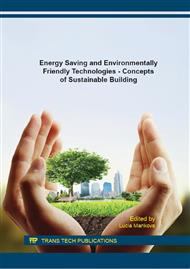p.527
p.536
p.544
p.552
p.563
p.571
p.579
p.589
p.598
Analysis of Thermal – Moisture Problems in Massive Wooden Sandwich Structures
Abstract:
This article focuses on hygrothermal problems in massive wooden sandwich structures. Wood in sandwich structures is already artificially dried before processing, and therefore does not further shrink, as it does in the case of log cabins. Analysed sandwich structure is composed from three layers, and is formed of wooden beam in interior side, thermal insulation and wooden beam in the exterior side. The composition of analysed structure is considered in different thickness with respect to the required heat transfer coefficient. Massive wooden beam on the exterior side causes troubles which exhibits in the reducing capacity of diffusion of water vapor. It is therefore possible that water vapor condenses on the interface of wood and the thermal insulation under certain boundary conditions. Therefore, it is appropriate to place massive wooden beam closest to the interior side. This solution would improve the balance of the diffusion permeability to water vapor permeating from the interior side to the exterior side.
Info:
Periodical:
Pages:
563-570
Citation:
Online since:
January 2016
Authors:
Price:
Сopyright:
© 2016 Trans Tech Publications Ltd. All Rights Reserved
Share:
Citation:


